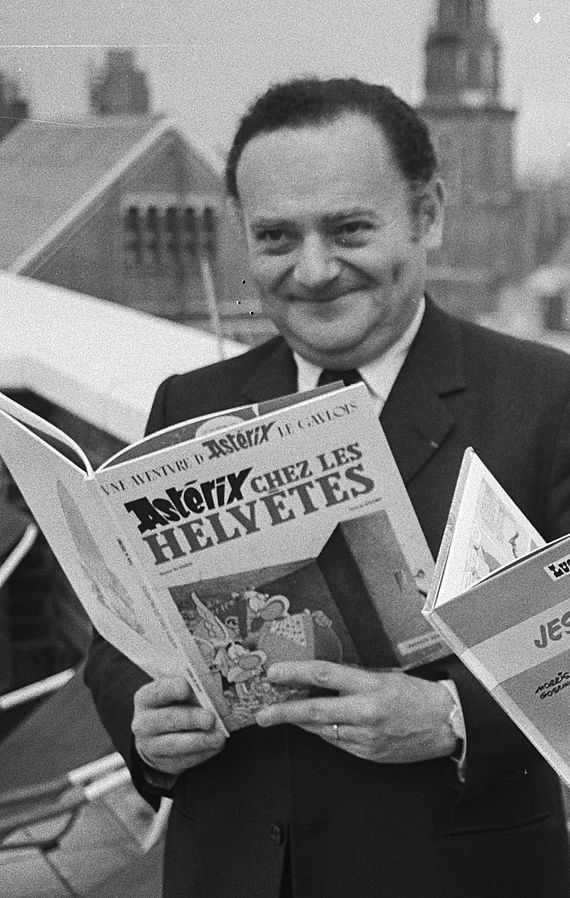René Goscinny
, 1926 - 1977
René Goscinny was born in 1926 in Paris. He was the son of Jewish immigrants to France from Poland. Born in Paris, he moved with his family to Buenos Aires, Argentina, at the age of two. In 1943 he was forced into work by his father’s death, eventually gaining work as an illustrator in an advertising firm. Living in New York by 1945, Goscinny was approaching the usual age of compulsory military service. However, rather than join the United States Army, he elected to return to his native France to complete its year-long period of service. Throughout 1946, Goscinny was with the 141st Alpine Infantry Battalion, and found an artistic outlet in the unit’s official and semi-official posters and comics. His first commissioned illustrated work followed in 1947, but he then entered into a period of hardship upon moving back to New York City. Some important networking occurred thereafter with other emerging comic artists, before Goscinny returned to France in 1951 to work at the World Press Agency. There, he met lifelong collaborator, Albert Uderzo, with whom he co-founded the Édipresse/Édifrance syndicate and began publishing original material.
As Edipresse/Edifrance developed, Goscinny continued to work across a number of publications in the 1950s, including Tintin magazine from 1956. A key output from this period was a collaboration with Maurice De Bevere (1923–2001). They created together series of comics: about Lucky Luke (with Maurice), and about Asterix (with Uderzo). Goscinny worked with Jean Jacques Sempe and they created a series about boy called Nicolas.
The following year (1959), the syndicate launched its own magazine, Pilote; and the first issue contained the earliest adventure of ‘Astérix, the Gaul’, scripted by Goscinny himself, and drawn by Uderzo. On the back of Astérix, Pilote was a huge success, but managing a magazine was a challenge for the members of the syndicate. Georges Dargaud (1911–1990) – publisher of Tintin, and a major force in Franco-Belgian comics – saw the opportunity to purchase Pilote in 1960, and put it on a firmer footing, financially. Already the leading script-writer on the magazine, Goscinny was co-editor-in-chief of Pilote from 1960. Such was its success that by 1962, he was able to leave Tintin magazine in to edit Pilote full-time, and he held that role until 1973.
Goscinny’s success with Astérix and Lucky Luke (published in serialized instalments in the magazine, as well as in album-form by Dargaud) saw him enjoy a comfortable life, but this arguably contributed to his growing ill-health. He had married in 1967 – to Gilberte Pollaro-Millo – and a daughter – Anne Goscinny – was born the following year, as he continued to work with Uderzo and others. Pilote and Astérix were sufficiently profitable to be a full-time job, and twenty-three Astérix adventures were completed by 1977, when Goscinny died suddenly of a cardiac arrest during a routine stress test. Uderzo completed the story Astérix chez les Belges [Asterix in Belgium] and continued the series alone.
Goscinny was not only a comic book author but also a director and co–director of animated movies (Daisy Town, Asterix and Cleopatra), feature movies (Les Gaspards, Le Viager). Goscinny. He died in 1977 in Paris.
Sources:
bookreports.info (accessed: September 14, 2018)
britannica.com (accessed: September 14, 2018)
lambiek.net (accessed: September 14, 2018)
Bio prepared by Agnieszka Maciejewska, University of Warsaw, agnieszka.maciejewska@student.uw.edu.pl and Richard Scully, University of New England, Armidale rscully@une.edu.au
Records in database:
- Asterix and Cleopatra [Astérix: Astérix et Cléopâtre] (Astérix, 6)
- Asterix and the Laurel Wreath [Astérix: Les Lauriers de César] (Astérix, 18)
- Asterix at the Olympic Games [Astérix: Astérix aux Jeux olympiques] (Astérix, 12)
- Asterix in Switzerland [Astérix chez les Helvètes] (Astérix, 16)
- Asterix the Gladiator [Astérix: Astérix gladiateur] (Astérix, 4)
- The Mansions of the Gods [Astérix: Le Domaine des Dieux] (Astérix, 17)



